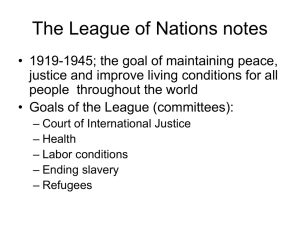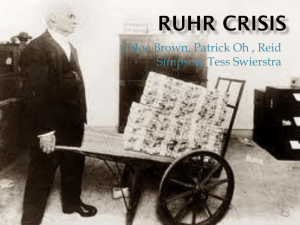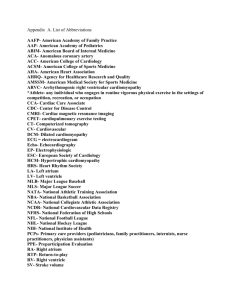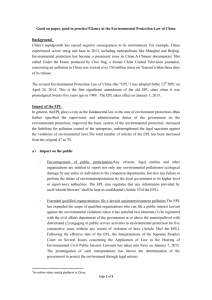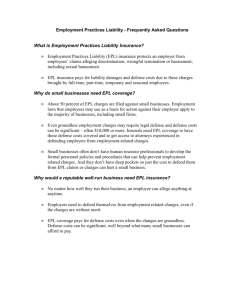Competitive Balance in the English Premier League
advertisement
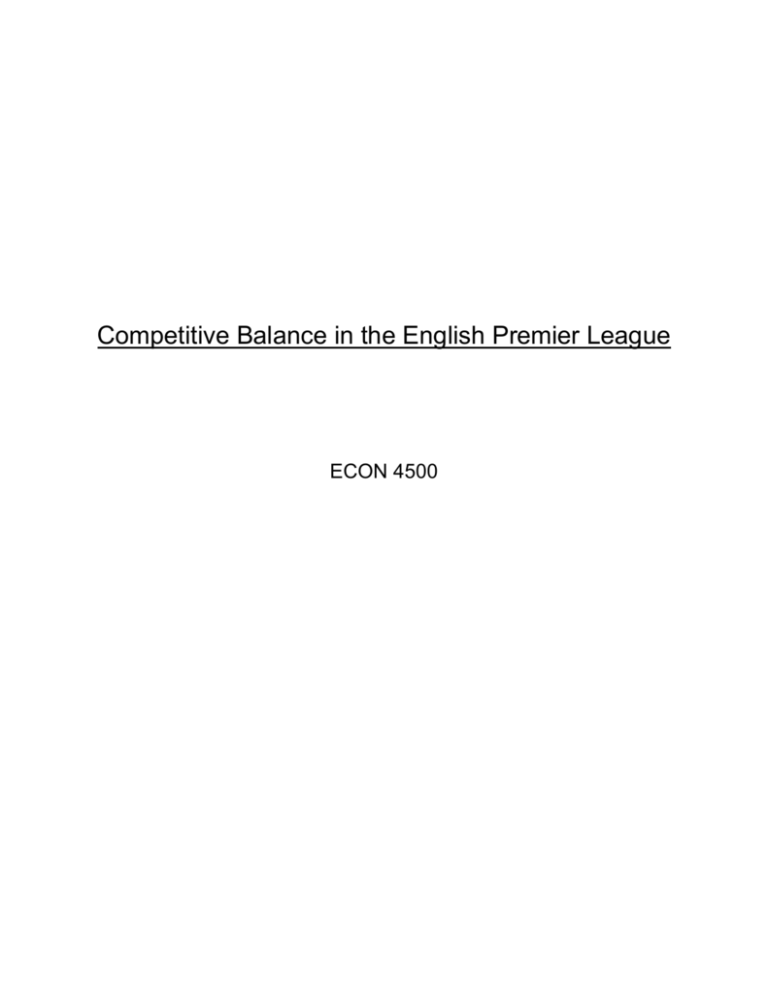
Competitive Balance in the English Premier League ECON 4500 Introduction: Competitive balance is an extremely important topic in the world of sports. Not only does it allow fans to see exciting games and seasons, but it has an effect on team and league revenues, player salaries, and the overall demand for a sport. Competitive balance is imperative to the success of any league, and almost every professional sport has had some attempt made to alter the competitive balance in an effort to increase the success of that league. Although competitive balance and the severity of its impact on a league vary from sport to sport, the underlying principle of the uncertainty of outcome hypothesis is universal. The uncertainty of outcome hypothesis states that fans are most interested in games when the home team has a 60 to 70 percent chance of winning.1 Ultimately, a more competitively balanced league, one where the most teams have an equal chance of winning, will be more successful in the eyes of owners and fans alike. This paper will attempt to analyze the competitive balance of the English Premier League and how it has changed over the last three years, from 2006/07 to 2008/09. After reviewing other findings on the subject of competitive balance, I will measure the competitive balance of the EPL for each three seasons, determine whether balance exists or not, and then assess the factors attributing to these results. Literature Review: Many academic papers and journals have been written about competitive balance, most likely as a result of its importance in the wide world of sports. From fan 1 Leeds, Michael A, and Peter von Allmen. The Economic of Sports . 3rd ed. Boston, MA: Pearson, 2008. 149. Print. attendance to media revenues, competitive balance is a factor that cannot be ignored. Considering the effect it has on the demand for a sport, competitive balance plays a crucial role in fan attendance of any league. In regards to the English Premier League, Stefan Szymanski believes the EPL offers a natural experiment for measuring the relationship between competitive balance and fan interest. Because teams simultaneously compete in both the EPL and FA Cup matches, the trends of fan attendance are comparable. He found that income inequality between divisions had grown, implying that the FA Cup was becoming more unbalanced than the EPL.2 As a result, fan attendance steadily declined for same-division matches. In summary, the more unbalanced a league is the less fan attendance they will see. According to Michie and Oughton, there are different aspects within competitive balance that must be understood in order to fully comprehend its effects on the league. Mentioned earlier, the uncertainty of outcome is important to competitive balance, particularly to spectators and TV viewers. When the outcome is predictable with a degree of certainty, spectators decrease compared to when the outcome is less certain, thus revenues are lower and the league is less successful. Long-term domination is also an important aspect of competitive balance. During the first 12 years of the EPL, one club (Manchester United) won the title 8 times, and two clubs (Man U and Arsenal) have won 11 titles.3 From a rank-order perspective, the EPL seems to be very unbalanced. Finally, there is seasonal uncertainty, where the uncertainty of outcome as to who is 2 Szymanski, Stefan. "Income Inequality, Competitive Balance and the Attractiveness of Team Sports: Some Evidence and a Natural Experiment from English Soccer." Economic Journal 111.469 (2000): 4. W eb. 18 Nov 2009. <http://ideas.repec.org/a/ecj/econjl/v111y2001i469pf69 -84.html#provider>. 3 Michie, Jonathan, and Christine Oughton. "Competitive Balance in Football: Trends and Effects." SportsNexus (2004): 9. W eb. 18 Nov 2009. <http://www.sportsnexus.co.uk/resources/12028/assets/football/CompetitiveBalance.pdf>. going to win the championship is central.4 Simply put, the chance any team will win is determined throughout the season. If the championship outcome was determined early on in the season, the later games would be less important and demand for those games would decrease. Measurements: For my analysis, I measured the competitive balance over 3 seasons of the EPL using within-season variation. To do this, I found the win percentage for each team and calculated the standard deviation from the mean win percentage (.500).5 Results show first, that the league was much more balanced in the first season (2006/07) than in recent years. From 2006/07 to 2007/08, the standard deviation increased by about 27%, a fairly significant jump. Second, while the lower positioned teams seem to be somewhat mixed, the same 4 teams are at the top of the table each year. At first glance, the EPL seems to have very poor competitive balance. I found the standard deviation for the 2006/07 season to be .177. While this number alone means very little other than it is a relatively small deviation, when compared to the later season it can explain quite a bit. For instance, the standard deviation in 2007/08 was .226, as noted earlier a 27% increase. Competitive balance was severely reduced. However, balance improved in the most recent season (2008/09) with a standard deviation of .207.5 4 Michie, Jonathan, and Christine Oughton. "Competitive Balance in Footb all: Trends and Effects." SportsNexus (2004): 9. W eb. 18 Nov 2009. <http://www.sportsnexus.co.uk/resources/12028/assets/football/CompetitiveBalance.pdf>. 5 See attached Excel tables Within-season variation is only one of many measures of competitive balance. Based on my calculations, the competitive balance of the EPL seems to be good and fairly stable as of late, but it is hard to say when there is no base for comparison. A comparison across sports or leagues can be done using the ratio of actual standard deviation to the ideal standard deviation.6 For example, when comparing the EPL to Major League Soccer (MLS) one can calculate the ideal standard deviation by dividing .5, which is the 50% chance each team has to win, by the square root of the number of games played by each team. This allows comparison because it provides the base (ideal) standard deviation for each sport/league. Another useful measure of competitive balance can be done using betweenseason variation. Also known as turnover or team-specific variation, it is distinguished from within-season variation in that it measures the relative positions of teams in the standings each year rather than in one given season.6 This takes into account that each year a team has a chance to move up in the standings. However, this measure does have one flaw in that it does not allow for a standard comparison like within-season variation does. Finally, the frequency of championships also can be used to measure competitive balance within a league. It is based on the same principles as the previous measure, but uses championships rather than league standings to compare balance. For example, the three seasons of the EPL used in this analysis show that the “Big 4” (Liverpool, Man U, Chelsea, and Arsenal) make up the top four teams all three years. 6 Leeds, Michael A, and Peter von Allmen. The Economic of Sports . 3rd ed. Boston, MA: Pearson, 2008. 149, 156, 158. Print. With the same teams always at the top, the league seems to be very unbalanced. Considering that in 12 years of the EPL only two teams won 11 of the championships, the balance in the EPL seems to be nonexistent. Altering Competitive Balance: There are many actions leagues can take to preserve competitive balance, including revenue sharing, salary caps or luxury taxes, and a draft system. The EPL has a revenue sharing plan in place where each club gets $44.4 million from the TV broadcasting deal each year.7 While the exact impact the revenue sharing deal has on the competitive balance in the league is difficult to determine, it is almost certain that the league is more balanced than without it. With revenue sharing, less wealthy teams are provided a better chance at higher-priced, better quality players, in turn promoting the competitive balance within the league. Salary caps work almost in reverse order as revenue sharing does, in that they restricts the wealthier teams’ ability to buy all of the top talent. Without a salary cap, teams in the league can spend as much money on players as they would like, and those more well-off teams will have better opportunity for the better players. This decreases competitive balance as it increases the chances of the better, more expensive players being on the same team. Currently, the EPL does not have a salary cap in place and teams can offer any amount of money to entice a player to sign with their team. For 7 "EPL Teams Earn Almost $1.59B As Part Of Payout From TV Deal." Sports Business Daily 16 May 2008: n. pag. W eb. 18 Nov 2009. <http://www.sportsbusinessdaily.com/article/120914>. example, Manchester City purchased Carlos Tevez for €35 million from Manchester United, while James Collins went to Aston Villa for only €6.7 million.8 Finally, a draft, especially a reverse-order entry draft, can help promote competitive balance. A reverse-order entry draft allows teams to choose incoming players in the reverse order from their finish in the previous season.9 By allowing the worst teams the first choice in the draft, more wealthy teams’ have restricted access to these players which helps balance the league. Rather than a draft, the EPL uses a transfer window, where there are certain times during the season in which teams may pursue players and purchase or loan players across teams. Because this does not hinder the more wealthy teams from buying all the talent, it does not do well at promoting competitive balance. Conclusion: Competitive balance is crucial in the success of any league. It allows a maximum number of fans, ultimately maximizing revenues for the league. While there are many measures of competitive balance, no one is better than another. Rather, depending on the scenario or league in question, one measure may be more useful than another. Based on the within-season variation calculations and analysis of the factors of 8 "Football: English Premier League transfers in 2009/2010 season." Sports Betting Information. 2009. W eb. 18 Nov 2009. <http://www.betinf.com/england_transfer.htm>. 9 Leeds, Michael A, and Peter von Allmen. The Economic of Sports . 3rd ed. Boston, MA: Pearson, 2008. 149, 156, 158, 163. Print. competitive balance, the EPL does not seem to be competitively balanced. With the same four teams in the top four positions over the three seasons considered, no salary cap in place, and no useful draft system, the competitive balance is likely far from what it could be. Appendix 2006/07 Standard Deviation: Team Wins Losses Total Win % (Win % - .5) Squared Man U 28 5 33 0.848 0.348 0.121 Chelsea 24 3 27 0.889 0.389 0.151 Liverpool 20 10 30 0.667 0.167 0.028 Arsenal 19 8 27 0.704 0.204 0.041 Tottenham 17 12 29 0.586 0.086 0.007 Everton 15 10 25 0.600 0.100 0.010 Bolton 16 14 30 0.533 0.033 0.001 Reading 16 15 31 0.516 0.016 0.000 Portsmouth 14 12 26 0.538 0.038 0.001 Blackburn 15 16 31 0.484 -0.016 0.000 Aston Villa 11 10 21 0.524 0.024 0.001 Middlesbrough 12 16 28 0.429 -0.071 0.005 Newcastle 11 17 28 0.393 -0.107 0.011 Man City 11 18 29 0.379 -0.121 0.015 West Ham 12 21 33 0.364 -0.136 0.019 Fulham 8 15 23 0.348 -0.152 0.023 Wigan 10 20 30 0.333 -0.167 0.028 Sheffield 10 20 30 0.333 -0.167 0.028 Charlton 8 20 28 0.286 -0.214 0.046 Watford 5 20 25 0.200 -0.300 0.090 Sum 0.627 Std Deviation 0.177 2007/08 Standard Deviation: Team Wins Losses Total Win % (Win % - .5) Squared Man U 27 5 32 0.844 0.344 0.118 Chelsea 25 3 28 0.893 0.393 0.154 Arsenal 24 3 27 0.889 0.389 0.151 Liverpool 21 4 25 0.840 0.340 0.116 Everton 19 11 30 0.633 0.133 0.018 Aston Villa 16 10 26 0.615 0.115 0.013 Blackburn 15 10 25 0.600 0.100 0.010 Portsmouth 16 13 29 0.552 0.052 0.003 Man City 15 13 28 0.536 0.036 0.001 West Ham 13 15 28 0.464 -0.036 0.001 Tottenham 11 14 25 0.440 -0.060 0.004 Newcastle 11 17 28 0.393 -0.107 0.011 Middlesbrough 10 16 26 0.385 -0.115 0.013 Wigan 10 18 28 0.357 -0.143 0.020 Sunderland 11 21 32 0.344 -0.156 0.024 Bolton 9 19 28 0.321 -0.179 0.032 Fulham 8 18 26 0.308 -0.192 0.037 Reading 10 22 32 0.313 -0.188 0.035 Birmingham 8 19 27 0.296 -0.204 0.041 Derby County 1 29 30 0.033 -0.467 0.218 Sum 1.022 Std Deviation 0.226 2008/09 Standard Deviation: Team Wins Losses Total Win % (Win % - .5) Squared Man U 28 4 32 0.875 0.375 0.141 Liverpool 25 2 27 0.926 0.426 0.181 Chelsea 25 5 30 0.833 0.333 0.111 Arsenal 20 6 26 0.769 0.269 0.072 Everton 17 9 26 0.654 0.154 0.024 Aston Villa 17 10 27 0.630 0.130 0.017 Fulham 14 13 27 0.519 0.019 0.000 Tottenham 14 15 29 0.483 -0.017 0.000 West Ham 14 15 29 0.483 -0.017 0.000 Man City 15 18 33 0.455 -0.045 0.002 Wigan 12 17 29 0.414 -0.086 0.007 Stoke City 12 17 29 0.414 -0.086 0.007 Bolton 11 19 30 0.367 -0.133 0.018 Portsmouth 10 17 27 0.370 -0.130 0.017 Blackburn 10 17 27 0.370 -0.130 0.017 Sunderland 9 20 29 0.310 -0.190 0.036 Hull City 8 19 27 0.296 -0.204 0.041 Newcastle 7 18 25 0.280 -0.220 0.048 Middlesbrough 7 20 27 0.259 -0.241 0.058 WBA 8 22 30 0.267 -0.233 0.054 Sum 0.854 Std Deviation 0.207 Sources "EPL Teams Earn Almost $1.59B As Part Of Payout From TV Deal." Sports Business Daily 16 May 2008: n. pag. Web. 18 Nov 2009. <http://www.sportsbusinessdaily.com/article/120914>. "Football: English Premier League transfers in 2009/2010 season." Sports Betting Information. 2009. Web. 18 Nov 2009. <http://www.betinf.com/england_transfer.htm>. Leeds, Michael A, and Peter von Allmen. The Economic of Sports. 3rd ed. Boston, MA: Pearson, 2008. 149, 156, 158, 163. Print. Michie, Jonathan, and Christine Oughton. "Competitive Balance in Football: Trends and Effects." SportsNexus (2004): 9. Web. 18 Nov 2009. <http://www.sportsnexus.co.uk/resources/12028/assets/football/Compe titiveBalance.pdf>. Szymanski, Stefan. "Income Inequality, Competitive Balance and the Attractiveness of Team Sports: Some Evidence and a Natural Experiment from English Soccer."Economic Journal 111.469 (2000): 4. Web. 18 Nov 2009. <http://ideas.repec.org/a/ecj/econjl/v111y2001i469pf69 84.html#provider>.



